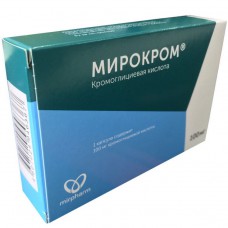Expiration date: 04/2027
Composition
Composition per capsule: Active substance: Sodium cromoglycate 100.0 mg Capsules: body: Titanium dioxide (E171) 2% Gelatin up to 100% Lid: Titanium dioxide (E171) 2% Gelatin up to 100%
Dosage form
Solid gelatin capsules No. 2, the body and lid are white. The contents of the capsules are white or almost white powder. It is allowed to have capsular mass seals in the form of a column or tablet, which crumble when pressed with a glass stick.
Pharmacodynamics
An antiallergic agent, it has a membrane stabilizing effect, prevents the degranulation of mast cells and the release of histamine, bradykinin, leukotrienes and other biologically active substances from them. Prevents the development, but does not eliminate the symptoms of immediate allergic reactions. When taken orally in patients with mastocytosis, relief of symptoms from the gastrointestinal tract (diarrhea, abdominal pain) and skin (urticaria, itching) is observed at 2-6 weeks of treatment and persists for 2-3 weeks.
Pharmacokinetics
After oral administration, the absorption of sodium cromoglycate from the gastrointestinal tract is low (less than 1% of the dose), but its systemic clearance is high (plasma clearance is 7.9 ± 0.9 ml / min / kg), therefore, the accumulation of the drug does not occur. The binding to plasma proteins is approximately 65%. It is not metabolized. It is excreted unchanged through the intestines and kidneys in approximately equal proportions.
Indications for use
Food allergy (if there is a proven allergen) as monotherapy or in combination with a diet that limits the intake of allergen; • Ulcerative colitis (as an adjunct in combination with glucocorticosteroids (GCS) or sulfasalazine, as well as as the drug of choice in patients with hypersensitivity to sulfasalazine).
Contraindications
Hypersensitivity to sodium cromoglycate or any other component of the drug; • Children under 2 years of age. Use during pregnancy and breastfeeding During pregnancy (especially in the first trimester), caution should be exercised when prescribing the drug as well as when prescribing other medicines. The accumulated experience in the use of the drug during pregnancy confirms the absence of adverse effects of the drug on fetal development. During pregnancy, the drug should be prescribed only in cases where it is obviously necessary to take it. It has not been established whether sodium cromoglycate enters mother's milk, however, based on its physico-chemical properties, this can be considered unlikely. There were no reports confirming that the use of sodium cromoglycate by nursing mothers had any adverse effects on the child.
Use in children
Keep away from children
Side effects
Nausea, vomiting, diarrhea, abdominal discomfort, skin rash, joint pain. Allergic reactions are extremely rare.
Interaction
The combined administration of sodium cromoglycate and GCS allows you to reduce the dose of the latter, and in some cases completely cancel them. During the reduction of the dose of GCS, the patient should be under close medical supervision. The rate of reduction of the dose of GCS should not exceed 10% per week.
Method of administration and dosage
The drug is taken orally in the form of capsules or a solution prepared from the contents of the capsules (open the capsule, pour the contents into a glass, pour 1 teaspoon of hot boiled water into a glass, the resulting solution is diluted with 2 teaspoons of cold water). In case of food allergies, 15-20 minutes before meals, adults and children over 14 years of age are prescribed an initial dose of 200 mg 4 times a day; children aged 2 to 14 years - 100 mg 4 times a day. The maximum daily dose should not exceed 40 mg/kg. When a stable therapeutic effect is achieved, the dosage can be reduced to a minimum, ensuring the absence of symptoms of the disease. Patients who for some reason cannot avoid eating food containing allergens should take 1 dose 15 minutes before meals. The optimal dose is selected individually, but in the range from 100 to 500 mg. In case of accidental omission of the drug, it should be taken as soon as possible. If this time coincides with taking the next dose, then the missed dose is not taken.
Overdose
Since the drug Cromoglycic acid is absorbed very slightly, an overdose is unlikely. In case of overdose, medical supervision and, if necessary, symptomatic treatment are indicated.
Special instructions
Patients with a history of anaphylactic shock or other life-threatening conditions that occur when taking food should not use cromoglycic acid as an auxiliary drug. The patient should be warned about the need for regular use of the drug. The effect on the ability to drive vehicles and mechanisms has not been studied.
Release form
Capsules in the ind. up
Conditions of release from pharmacies
Without a prescription
Storage conditions
Store in a dry place
Expiration date
2 years


